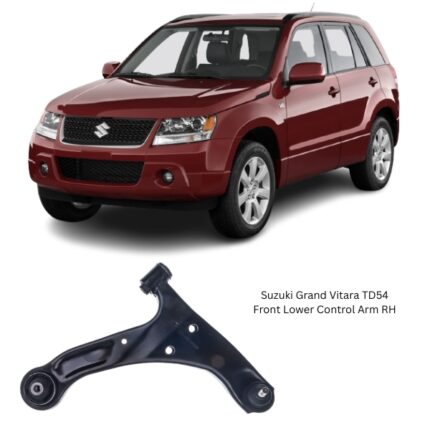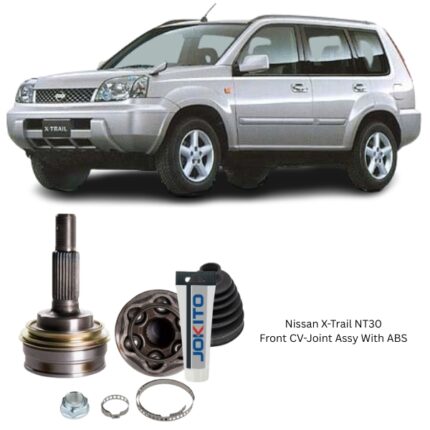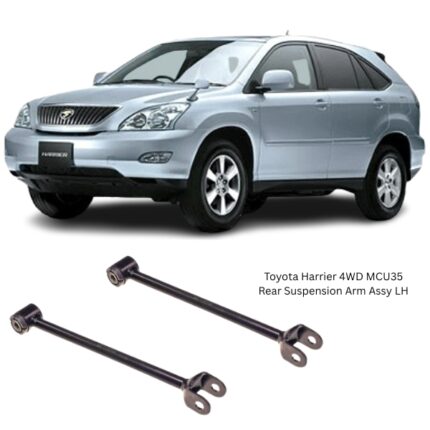-11%
Get Toyota Harrier 4WD MCU35 Rear Suspension Arm Assy LH 48730-48110 in Kenya
The Rear Suspension Arm Assembly Left-Hand (LH) is an essential component of a vehicle’s rear suspension system. Designed to provide a strong, flexible connection between the chassis and rear wheel assembly, this component plays a pivotal role in maintaining alignment, handling, ride comfort, and safety. Positioned on the left (driver’s side) of the vehicle, it is engineered to absorb dynamic road forces while preserving proper wheel tracking and suspension geometry.
Built for resilience and precision, the rear suspension arm is fundamental to the structural and functional integrity of your vehicle’s rear-end suspension setup.
What is a Rear Suspension Arm Assembly LH?
The Rear Suspension Arm Assembly LH is a mechanical link that joins the vehicle frame or subframe to the rear wheel hub or knuckle. Depending on the vehicle’s suspension design—multi-link, double wishbone, or trailing arm—it may control forward-backward, side-to-side, and even vertical wheel movement. It is usually equipped with bushings on the frame side and a ball joint or bushing on the wheel side, enabling controlled pivoting and alignment preservation during motion.
Positioned on the left-hand (LH) side of the rear axle, this assembly helps control the motion path of the left rear wheel as it moves over uneven terrain, turns, or brakes.
Key Functions of the Rear Suspension Arm Assembly LH
-
Controls Wheel Movement
Maintains correct wheel alignment and controls the range of motion of the rear left wheel through suspension travel. -
Supports Suspension Geometry
Ensures the rear suspension geometry—camber, caster, and toe—remains within manufacturer specs to maximize tire contact, handling, and safety. -
Absorbs and Distributes Road Forces
Helps dampen vibrations and shocks from the road by working in tandem with shock absorbers, springs, and bushings. -
Maintains Rear-End Stability
Provides structural integrity and rigidity to the suspension setup, especially under cornering, acceleration, and braking.
Design and Components
A typical Rear Suspension Arm Assembly LH includes:
-
Main Arm Body
Made from forged steel, aluminum alloy, or cast iron, offering a balance of strength and lightweight properties. -
Bushings
Generally rubber or polyurethane bushings are pressed into the ends to allow for slight movement while isolating noise and vibration. -
Ball Joint or Knuckle Mount
On certain suspension designs, the outer end may feature a ball joint or mounting point for direct attachment to the wheel knuckle. -
Reinforcement Ribs or Brackets
Some arms feature reinforced brackets or gussets for added strength, especially in performance or off-road vehicles.
Why the Rear Suspension Arm LH is Important
A properly functioning Rear Suspension Arm LH ensures:
-
Consistent Wheel Alignment
Reduces tire wear, improves fuel economy, and ensures the car handles as intended by the manufacturer. -
Predictable Handling
Keeps the rear end planted during aggressive cornering or rapid acceleration and deceleration. -
Improved Ride Comfort
Minimizes body roll, bump steer, and road harshness by guiding wheel travel and supporting the spring-dampening system. -
Safety Under Load
Maintains structural integrity even when carrying passengers or cargo in the rear, especially in SUVs, trucks, and vans.
Common Signs of a Worn Rear Suspension Arm LH
Over time, suspension arms and their components can deteriorate due to age, exposure, or impact. Look for these symptoms:
-
Clunking or knocking sounds from the left rear side when going over bumps.
-
Excessive tire wear on the inner or outer edge of the left rear tire.
-
Loose or unstable rear-end handling, especially while turning or braking.
-
Poor alignment or the car pulling to one side.
-
Visible cracks, rust, or deformation on the arm.
-
Vibrations or noises when driving at high speeds or over uneven surfaces.
These are signs the arm or its bushings/ball joint may be compromised and require replacement.
Performance Benefits of a New Suspension Arm Assembly
Replacing a damaged or worn-out rear suspension arm with a high-quality assembly brings multiple benefits:
-
✅ Restores Factory Suspension Performance
-
✅ Improves Tire Life and Reduces Uneven Wear
-
✅ Enhances Cornering Stability and Traction
-
✅ Reduces Cabin Noise and Vibrations
-
✅ Eliminates Rear-End Instability or Wobble
By restoring the original suspension geometry, your vehicle becomes more predictable and comfortable to drive, enhancing both safety and driver confidence.
Material and Build Quality
Premium Rear Suspension Arm LH units are manufactured to OEM or higher standards, featuring:
-
High-tensile forged or cast materials to withstand road stress and impact.
-
Corrosion-resistant finishes such as e-coating, powder coating, or galvanization.
-
High-durability bushings for optimal noise/vibration/harshness (NVH) reduction.
-
Pre-installed components like bushings or brackets for plug-and-play replacement.
In performance or rugged-use vehicles, you may also find arms with beefier structures or adjustable geometry features.
Installation and Replacement
Replacing a Rear Suspension Arm LH typically involves:
-
Lifting the vehicle and supporting it safely with jack stands.
-
Removing the rear wheel on the left-hand side.
-
Unbolting the old suspension arm from the subframe and knuckle.
-
Inspecting all related parts, including bushings, bolts, and the sway bar link.
-
Installing the new arm and torquing all bolts to spec.
-
Realigning the rear suspension geometry using a professional wheel alignment system.
Important: After replacement, a four-wheel alignment is recommended to ensure correct camber and toe settings.
Care and Maintenance Tips
-
Regularly inspect for wear, rust, or damage especially after long trips or heavy load use.
-
Grease or lubricate fittings (if applicable) during service intervals.
-
Replace in pairs for balanced suspension behavior (LH & RH).
-
Always follow torque specifications during installation.
Follow us on Facebook for more parts.





Reviews
Clear filtersThere are no reviews yet.